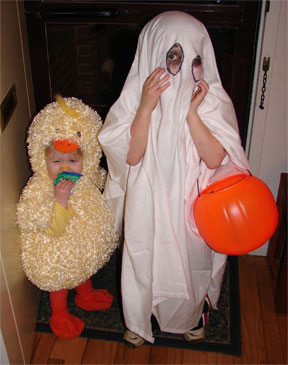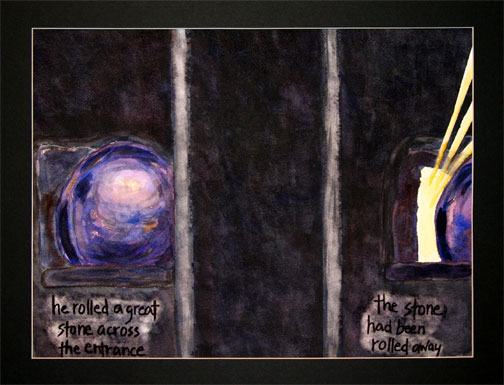The first part of an Easter sermon called “Ghost Story”
Permalink for the sermon
I’ve always had a love/hate relationship with ghost stories. As a boy, a part of me wanted to hear about ghosts and monsters and the like just to prove how tough I was. Another part of me wanted to dive under the covers whenever somebody was about to tell a scary story.
 My friend Keith liked to tell ghost stories to scare me, until one night when he had an encounter with a real ghost. After filling his mind with ghostly terrors just before bed, Keith didn’t sleep well. He tossed and turned all night, pulling his sheets and blankets out of place as he thrashed around in bed.
My friend Keith liked to tell ghost stories to scare me, until one night when he had an encounter with a real ghost. After filling his mind with ghostly terrors just before bed, Keith didn’t sleep well. He tossed and turned all night, pulling his sheets and blankets out of place as he thrashed around in bed.
Very early in the morning Keith had a nightmare. He dreamt that a ghost was attacking him, holding him by the throat and choking him. In his dream, Keith grabbed the ghost’s arms and tried to pull him away, but to no avail. The ghost was too strong. Soon the dreaming Keith began to feel like he was suffocating. It was a horrifying moment.
He suddenly woke up, only to see what appeared at first to be a ghost actually choking him. As he struggled to make sense of what was happening to him, Keith realized that one of his white bedsheets was wrapped around his neck. Like in his dream, Keith was trying to pull the “arms” of the sheets away. But, in so doing, he was actually choking himself more. The real body of the real Keith was being suffocated by his sheet! Somehow Keith’s unconscious made up a dream to go along with reality. And, thankfully, he woke up before his “ghost” could finish its ghoulish task.
Well, as you can imagine, that was the end of ghost stories for Keith, at least for a long while. And, frankly, I didn’t mind.
Reassurance from Physics
I only wish that a paper recently published on the Cornell University Library website had been around when I was a boy. Last August, Costas J. Efthimiou, a theoretical physicist at the University of Central Florida, and his colleague, Sohang Gandhi, a grad student at Cornell, published a paper entitled, “Ghosts, Vampires and Zombies: Cinema Fiction vs Physics Reality.” These two scientists examined commonly held beliefs concerning such supernatural beings, arguing on the basis of rigorous methodology that they simply don’t exist. Zombies, for example, aren’t the undead who stalk the earth. Rather, they’re just normal people who were poisoned with the “highly toxic substance called tetrodotoxin.” This poison, which comes from the Pufferfish, can make somebody appear to be dead long enough for a quick burial. But, after a while, that person can wake up. Science has yet to determine why they stumble around with their arms pointed strangely forward.
Ghosts, the scientists argued in their paper, are physically impossible because the essential immateriality of their nature, that which allows them to pass through walls, precludes their being able to walk around at all. Walking requires forces explained by Newton’s Laws of Motion. An immaterial being would not be able to exert the physical force required for walking, or even to stand upon a solid surface. The authors of the paper went so far as to wonder why ghosts need to “mimic human ambulation” anyway. “This is a very slow and awkward way of moving about in the scheme of things,” they sagely observed. So, the bottom line: Be reassured! There are no ghosts, no vampires, and no zombies.
Did the Disciples See a Ghost?
As we read Luke 24, it’s obvious the disciples of Jesus didn’t have the benefit of scientific disproof of the supernatural. When Jesus Himself stood among them after His death, they “were startled and terrified, and thought that they were seeing a ghost” (v. 37). They knew enough to realize that dead bodies don’t come back. And they knew enough about what had happened to Jesus two days earlier to know that He was really dead. So, seeing something that looked like Jesus, they could only conclude that it was a “ghost” or “spirit,” as the Greek literally reads. Naturally, they were plenty spooked!
You just gotta love those disciples! Even after the resurrection, they still had the hardest time getting things right. Though they had heard that Jesus had risen from the dead, and though Jesus Himself had predicted this, when He appeared among them, they freaked out. Now I don’t know about you, but this gives me lots of hope. It means that I don’t have to be a paragon of faith to be a disciple of Jesus. It means I can have my doubts, my fears, and my confusions, and still be the kind of person Jesus accepts, no, the kind of person Jesus chooses, to be one of His disciples. If you’re someone who struggles with faith, if you find yourself doubting and confused, you should be mightily encouraged by this story. You’re just the sort of person Jesus wants on His team. (Click here to read the rest of this sermon.)
More from Beliefnet and our partners

